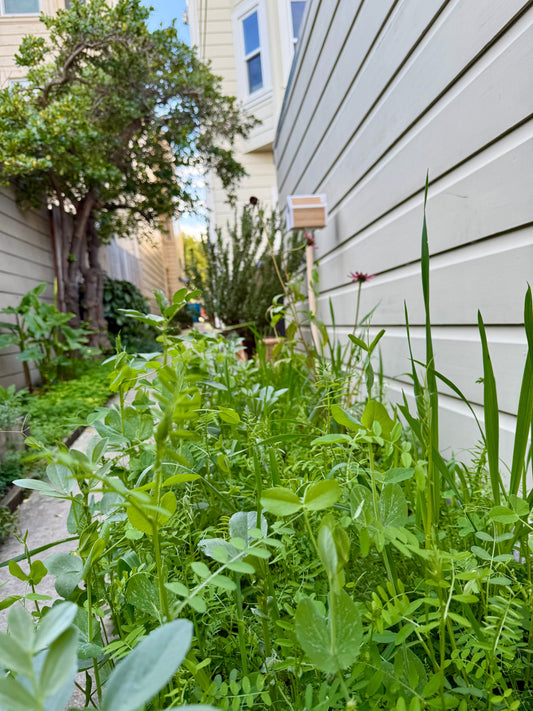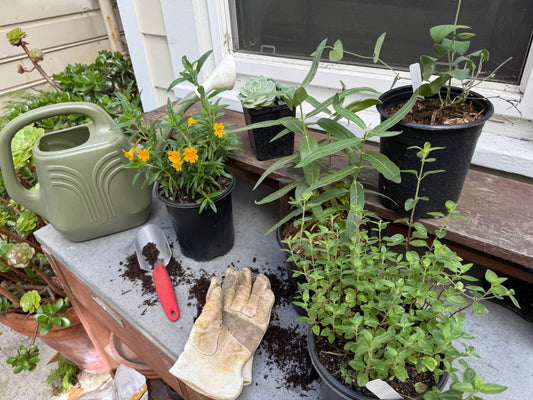It’s October in the garden and the weather is friggin fantastic. It’s been in the 80's several days this week! October in San Francisco is objectively beautiful - warm weather, summer’s fog and wind a distant memory, the air is warm and sweet and alluring. October is San Francisco’s brief foray into experiencing that California lifestyle we sell to the rest of the world on postcards. As a gardener in San Francisco though, October is fraught with deception. Beautiful warm days, light breezes and birds singing are the siren song lulling us into a sense of optimism about the months ahead. “It’s finally so beautiful out - I’m not ready for the gardening season to end! Maybe I should plant a cool-season vegetable crops! Oh think of the joys we’ll have harvesting broccolis and cabbages, kales, Brussels and chards all winter long!”
With San Francisco’s mild winter climate, you absolutely can grow cool season crops all winter long. I sowed Rainbow Chard seeds in the garden a decade ago and they still manage to pop up in random places every January. But October’s beautiful weather belies a darker truth - it’s about to get cold — and wet. Soon the days are going to be approximately 37 minutes long followed by seemingly everlasting dark nights, copious amounts of rain (hopefully), and conditions generally not fabulous for working in the garden.
So what’s a San Francisco gardener to do? Plant Cover Crops! Growing cover crops in the raised vegetable beds is one of my favorite fall/winter garden activities. They’re quick and easy to get started and require essentially zero attention once they’re established. They passively create healthier happier soil, and they invite a host of beneficial critters into your garden - both above and below the soil line. Cover crops planted in fall are a fantastic way to keep the gardening spirit going through the winter while bringing incredible benefits to your garden.

Cover crops maturing in the raised beds, November-March
Simple Crop Rotation for a Healthier Garden
Fall/Winter: Plant cover crops to restore your soil and have a hands-off garden when you probably want to be indoors anyway.
Late Winter/Early Spring: Plant cool season crops as the days begin to grow longer and that itch to get out into the garden starts to call.
Late Spring/Summer: Plant warm season crops to take advantage of long sunlight hours and warm(ish) soil and air temperatures.
Practicing basic principles of crop rotation helps keep your garden healthy and happy and gives you a break from gardening during the least-outdoorsy time of the year. Cover crops are also great for a quick visit as you pass through the garden. Fast-growing, something is always new and changing, the chaotic nature of your seed mix makes your garden bed an ever-changing visual composition, and as your crops begin to flower, there's almost always a fuzzy bumblebee or some other random critter meandering about that makes you stop, slow your breathing and realize there's a whole universe of life out there not governed by an inbox or an Outlook calendar.
What Are Cover Crops?
Cover crops are non-harvested plants grown to protect and enrich the soil between planting periods. Cover crops can improve soil health, help with erosion control, and provide the soil with beneficial nutrients. They can also help suppress weeds, manage pests and diseases and improve the biodiversity of your soil. What’s not to like?
In the garden, cover crops are typically cut or mowed down at the base once the plants reach maturity and before they begin to fruit, creating a dense organic layer of mulch which continues to aid in weed suppression and helps the soil retain moisture. As this cover crop mulch - sometimes referred to as “green manure” - decomposes, it acts as a slow-release fertilizer returning valuable nutrients to the soil. That decomposition process also invites more beneficial microbes, molds, fungi and other helpful critters into your soil biome.
Common Types of Cover Crops
While all cover crops provide some level of nutrient scavenging, prevent soil erosion, generate biomass (“green manure”) aid in weed suppression and relieving soil compaction there are three main types of cover crops, each providing their own unique benefits.
Legumes like clover, peas, beans and vetches help fix nitrogen in the soil. How they work is really pretty cool. As the plants are in their growth phase, they absorb copious amounts of nitrogen from the atmosphere. They metabolize and store this nitrogen in nodules along their roots. After the plant flowers and those flowers are pollinated, the plants then tap into those nitrogen stores to produce their fruit (peas, beans, etc.). When legumes are mowed down before fruiting, the roots with their nitrogen nodules are left in place in the soil, making that nitrogen readily available to your crops in the following season.
Grasses and Cereals like winter rye, oats and barley help prevent soil erosion with their extensive root systems, which also aid in preventing soil compaction and helping aerate the soil, making it more permeable. They also scavenge and capture critical soil nutrients, preventing them from runoff during winter’s rains. Grasses and cereals aid in weed suppression by competing for resources and blocking sunlight, and they also contribute significantly to the garden’s green manure, creating a large amount of biomass for mulch that will later break down and replenish nutrients in the soil.
Brassicas like broccoli, kale, Brussels sprouts, and mustard improve soil health through biofumigation. They act as the soil’s pest and disease control by suppressing nematodes, weeds and diseases and producing compounds known as glucosinolates that are released into the soil as they decompose. In the home garden, this is particularly important in vegetable beds where nutrient imbalances and increases in soil-borne diseases and pests are common if the same crops are grown in the same soil year after year. Bonus round: Daikon! If your soil is significantly compacted, large radishes like the mighty Daikon can help drill deep into the soil to reduce soil compaction. Unlike other cover crops, radishes are typically harvested from the soil rather than leaving the root vegetables in place. The radishes can be consumed or composted.
How to Use Cover Crops in the Garden
Growing cover crops is dead simple. Clear your bed(s) of any remaining summer crops. If you’ve used a mulch, remove that as cover crop seeds need soil contact to germinate. Choose your cover crops - I prefer a mix that includes seeds from each of the three types: legumes, grasses/cereals, and Brassicas. Heavily sow your seeds across your planting area, being sure to get even coverage across the entire bed. Give the beds a good initial watering and keep them watered until our winter rains kick in and can take over the task. If we have a dryer winter, be sure to keep an eye on your soil and provide supplemental watering as needed. The easiest test of soil dryness is “the finger test.” Stick your finger about two inches into the soil. If the soil is moist, you’re good to go; if it’s dry, it’s time to water.
Time to Meet the Reaper
Cover crops stop being useful as soon as they start to produce fruit - which in our case can means seeds, peas and beans. Once plants start producing their fruit, they begin to tap into all those stored nutrients they’ve been gathering all season. So we want to stop that process ideally just before fruiting begins. I like to let my cover crops flower to attract local pollinators and feed honeybees from the hives we have a few doors down on Quane Alley. But once the flowering process begins, I start to keep a close eye on my crops. Once I see evidence of fruit forming, it’s time for the reaping.

Cut, don’t pull.
When it’s time to bid adieu to the lovely chaos that is your winter cover crop, it’s important to cut the crops off at or just above the soil level, leaving the roots intact in the soil. All that root growth has helped create a rich, healthy, complex ecosystem beneath the soil’s surface that we want to maintain. Hand tools like garden shears or pruners can be used to mow down your cover crops when the time comes. You may want to use the “chop and drop” method to not only cut down your crops at the base, but also to chop them up into smaller pieces to aid in decomposition and make them more manageable as a mulch. That’s it! Once your cover crops are dropped and chopped, your garden is ready for its next season’s crops.
What I’m Sowing…
I’ve chosen a mix of crops from all three types of covers, all for their benefits and some because they’re fun too.
- Common Buckwheat
- Lacy Phacelia
- Hairy Vetch
- Crimson Clover
- Fava Beans
- Miyashige White Daikon
- Yellow Mustard
For readers outside of the Bay Area who have an actual winter, you’re not left out in the cold! There’s still time to sow cover crops that have a fast growth rate and mature in as little as 30 days.
- Common Buckwheat - Days to Maturity: 30-40
- Lacy Phacelia - Days to Maturity: 45-60
NEW! Shop Cover Crop Seeds Online and Support The Quane Garden
We independently rate and recommend products we offer. When you buy through our links, we may earn a commission.
 |
| SHOP COMMON BUCKWHEAT |
 |
| SHOP LACY PHACELIA |
 |
| SHOP HAIRY VETCH |
 |
| SHOP CRIMSON CLOVER |
 |
| SHOP FAVA BEANS |
 |
| SHOP DAIKON RADISH |
 |
| SHOP SOIL BUILDER PEAS AND OATS |




